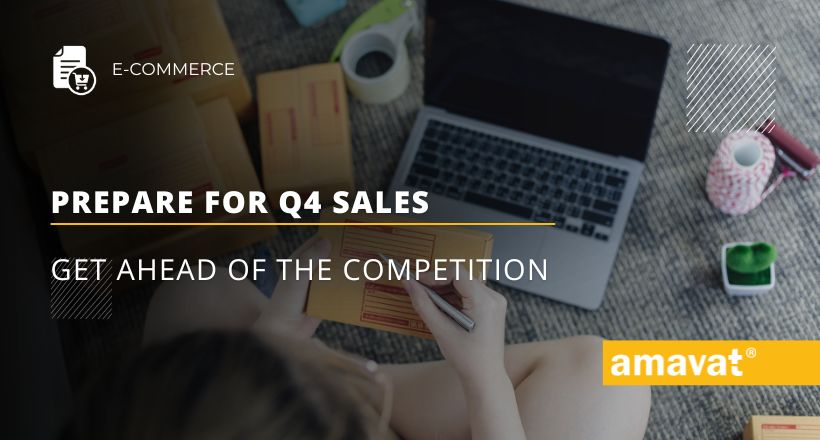Get ahead of the competition – Prepare for Q4 sales!
We are just moments away from the hottest shopping season in e-commerce. Today, we will focus on preparing for Q4, covering all key aspects — from developing strategies and meticulously scheduling important shopping holidays to positioning and planning PPC campaigns. How can you gain an edge when selling on marketplaces in Q4? Read on to find out!
E-export strategy
To prepare your company for exporting through online sales channels, it isn’t necessary to establish a branch abroad or hire local language-speaking staff. Initially, thorough preparation and good market research are more important.
Developing an e-export strategy isn’t something you do “on the fly.” It requires significant time and involvement from your team or external helpers, such as agencies that offer valuable support. Patience, accuracy, meticulousness, and openness are also crucial. A well-executed market analysis, covering the foreign market, competition, local consumer preferences, and available sales channels, will certainly pay off in the future. Realistically set goals will help minimize risk. Let’s look at what’s needed to develop an effective cross-border e-commerce strategy.
Identify target markets
Gather additional information about the economy and culture of the chosen markets—you can use official government websites, economic guides, media sources, and search engines. It’s important to check if there are any restrictions on imports or other regulatory requirements in the countries you’re targeting for the products you manufacture or distribute. Even if there is a large market demand, national regulations could hinder or slow down your expansion. When analyzing a country’s economy, pay attention to consumer data and habits, especially regarding e-commerce shopping. What shopping channels do they prefer, how often do they shop, and which payment and shipping methods are popular?
Analyze your product and competition
After initially identifying one or more target markets and gathering key information, it’s time to analyze your product and competition. The main goal here is to identify your opportunities in foreign trade and the strengths and weaknesses of your competitors.
First, check if the type of product you offer is available on foreign platforms and e-commerce stores or through non-Internet distribution channels. Are there similar or related products in e-commerce?
Create a list of competing brands, companies, and manufacturers selling similar products through e-commerce channels. Are their products similar, or are there significant differences? What sets their products apart, and what does your company offer that the competition lacks?
Next, analyze your competitors’ pricing, marketing, and sales strategies. Pay attention to the sales channels they use—are they present in one channel, many channels, or do they implement an omnichannel strategy? Do they export products to other markets? What is the basis of their competitive advantage? Is it just price? Finally, how strong is their brand, and how well-developed is their branding?
Define your pricing strategy
A crucial aspect of entering foreign e-commerce markets is defining your pricing strategy. This process aims to strike a balance between the profitability of international trade and the attractiveness of your offer to consumers.
In cross-border online trade, there are additional financial burdens that you don’t face in domestic trade, which will impact your margins and the final price for the customer. The first task is to gather all costs associated with selling abroad, including:
- Potential product adjustments to meet market requirements;
- Packaging orders and possible additional security measures;
- Order distribution;
- Differences in VAT rates;
- Potential customs duties and shipping fees for sales outside the EU;
- Currency conversions, bank fees, and transaction charges;
- Commissions and fees for selling on marketplace platforms;
- Insurance for international shipments.
The most important shopping holidays in Q4
The fourth quarter is full of events that attract hundreds of millions of consumers, making it an excellent opportunity for sellers who want to start selling on the platform and immediately enjoy high demand. However, as we mentioned above, to achieve this, preparations should begin well in advance. Which shopping holidays should you primarily consider in your strategy?
Prime Big Deal Days
Prime Big Deal Days is a period when Amazon Prime members can enjoy exclusive discounts, special offers, and access to a wide range of products at reduced prices. This event is often referred to as Fall Prime Day because it mirrors Prime Day, which takes place in October. It covers various product categories, from electronics and clothing to cosmetics, sports equipment, books, and more.
Black Friday
Black Friday is an informal shopping holiday that originated in the United States and dates back to the 1960s. It has continuously evolved, gaining popularity every year. Its name comes from a term used by Philadelphia police officers to describe the first Friday after Thanksgiving, which, due to the large crowds of shoppers, required them to work 12-hour shifts. Initially carrying negative connotations, over the decades, these were replaced by a positive narrative from retailers who quickly recognized the sales potential of the day and began competing with promotions to boost their results.
Black Friday arrived in Poland in 2013 and has steadily gained popularity over the past decade. Both Polish consumers and retailers eagerly await the promotional period and increased sales. According to data from Statista, the most popular product categories in 2023 were:
- Clothing and footwear (75% of shoppers)
- Electronics (55% of shoppers)
- Home accessories (49% of shoppers)
- Cosmetics (41% of shoppers)
Cyber Monday
Cyber Monday refers to the Monday following the American Thanksgiving weekend. Online retailers typically offer special promotions, discounts, and sales on this day, similar to Black Friday. Recently, the two holidays have almost merged, with the term “Black Weekend” gaining popularity, referring to the entire period between these events.
Single’s Day
The origins of Single’s Day, also known as Double Eleven, date back to the 1990s in China, but its history as a shopping event began in 2009 when Alibaba Group, one of the largest e-commerce platforms in the world, organized the first Double Eleven Shopping Festival. Jack Ma, the founder of the company, chose November 11 as an opportunity to attract the attention of Chinese consumers and stimulate online commerce. During the first Double Eleven, Alibaba prepared numerous promotions and discounts that attracted a large number of customers. In just one day, sales reached around $7.8 million.
The initial success of Single’s Day prompted other e-commerce players to follow suit, and soon the event became a nationwide and international phenomenon. Over the course of a few years, Double Eleven transformed into a global shopping holiday. Sales platforms began expanding their offers and promotions to include a wide range of products, from electronics and clothing to food and cosmetics.
Positioning
An extremely important aspect of selling on marketplaces in the fourth quarter is proper product positioning. The foundation of Amazon SEO is organic work, meaning all the free actions taken by sellers to improve their ranking in search results. Special attention should be paid to the following aspects:
- Price – It plays a significant role in the selection of a specific offer. Both customers and algorithms pay attention to it. A competitive price can increase sales levels.
- Customer service – It should always be at the highest level, increasing your chances of receiving positive reviews, which translates into a higher ranking in the search engine.
- Photos and texts – Content and photos are analyzed by algorithms that search for keywords in them to index the listing accordingly. It’s crucial to ensure an attractive format but also proper keyword saturation.
- Efficient logistics – A short delivery time and free shipping in the FBM or FBA model allow you to obtain the Prime badge, which translates into higher visibility of the offer.
When creating or optimizing a listing, special attention should be paid to the title, bullet points, search terms, and product technical data. The first two are key for Amazon SEO. It’s important to use all available space while incorporating as many keywords as possible—the strongest should be in the title. Additionally, ensure that keywords don’t repeat. Both the title and bullet points should be easy to read and convey the most important information. Search terms are also important—they are not visible on the listing. You can include many keywords here that you don’t want to display or for which there is no room. Technical data should provide detailed information about the product. These are crucial when customers use search engine filters, where much information appears. Even if it doesn’t apply to the product, it’s worth checking the “not applicable” box!
PPC campaigns
After ensuring proper organic positioning, you should focus on performance marketing, specifically PPC campaigns, which allow you to reach a wide audience of potential consumers. What are the basic types of ads you should include in your strategy?
Sponsored Products
The goal of Sponsored Products campaigns is to promote products to buyers actively searching for related keywords and competing products. These ads are charged on a CPC (cost-per-click) basis. There are two main configurations:
- Automatic – Once the ad is launched with the selected products, the campaign generates the necessary data based on the product page and information retrieved from the backend. The algorithm displays the ads in two designated places: search results and under competitor listings.
- Manual – The display rules are identical to automatic ads, except that you can choose and divide the targets within the ad into: keywords, competitor ASINs, and product categories. In other words, manual campaigns allow you to target specific keywords or competitor ASINs.
Sponsored Display
This type of ad targets large groups of Amazon customers and competitor products. They are charged in two models:
- CPC – cost-per-click,
- VPCM (Cost per 1,000 viewable impressions) – the cost per 1,000 viewable impressions, where at least 50% of the ad’s surface remains in the visible area of the browser window for at least 1 second.
Sponsored Display ads include brand logos, custom headlines, and audiovisual content. They enable the following targeting options:
- Targeting customers who purchased a product in the same category or a related category within a specified period (7-365 days),
- Targeting related product listings,
- Targeting customers who purchased the advertised product within a specified period (7-365 days),
- Targeting customers who viewed your ad within a specific period (7-90 days),
- Targeting categories where your product is listed.
Vouchers and promotions
These are percentage price reductions that impact not only conversion rates but also product positioning. They are visible on the Amazon search page and listings.
Summary
Let’s be clear – preparing for marketplace sales in Q4 is a multifaceted process that requires time, so it’s worth starting well in advance. Developing strategies, content, or obtaining the necessary documentation are just the basics of expansion. Proper positioning and promoting of products are additional aspects that require not only time but also expert knowledge.






